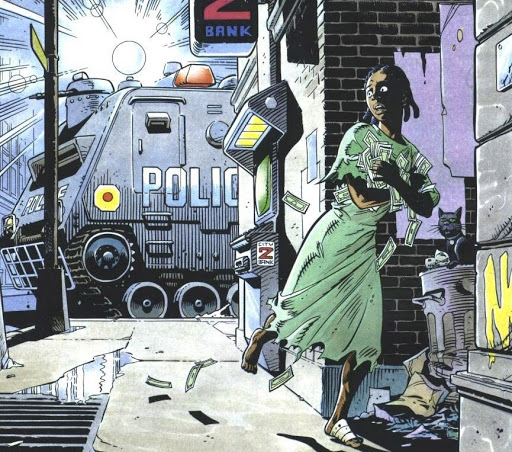Writer and artist Frank Miller is a sort of paradoxical figure among comic book readers. On the one hand, he wrote The Dark Knight Returns and Batman Year One. I mean, he basically invented the modern Batman. Those titles, along with his Daredevil run, helped usher in comic books “adult” enough for us to read in classes. But it’s also pretty widely understood that Miller is kind of, vaguely, a fascist. And sort of a racist. And I guess if we’re going to get into it, he’s not particularly fond of gay or disabled people either. It also seems really hard for him to write a female character who isn’t a sex worker and he certainly doesn’t like Muslims. These exaggerated, though not entirely unfounded, accusations make for awkward conversations about the roots of modern comics. Though Miller’s written some of the greats, he’s also written a few of the worst. Miller is thus one of the last people we would expect to write a strong, believable woman of color as a main character or deal with real social issues without being preachy or disrespectful. And this is weird, because he wrote Martha Washington.
Martha Washington first appeared in Give me Liberty, a 1990 4-issue miniseries published by Dark Horse, written by Frank Miller and drawn by Watchmen’s Dave Gibbons. Give me Liberty begins in the not-so-distant future of 1995 with the birth of Martha Washington. The following year Martha’s father is killed in a protest against the economic policies of President Rexell, a thinly veiled caricature of Ronald Reagan. The story follows Martha surviving in the government created slums until her eventual enlistment in the military.
Although the comic focuses on Martha, it is situated in a developing story about the political climate in America. Rexell is replaced with an idealistic liberal president when the white house is blown up by Saudi Arabian terrorists (I mentioned Miller’s feelings on Muslims, right?). The new president decides to deploy forces to save the rain forests (which I guess is what environmentalists cared about before climate change). This is when the story starts getting really weird. The rain forests are being threatened by Fat Boy Burger, a multinational fast food restaurant that wants to cut down the forests so that they can grow cattle on the newly cleared land. The Fat Boy Burger corporation fights with giant piloted robots that look like fat boys holding burgers. They also fight with horrifying chemical weapons.
Something Give me Liberty does particularly well is pairing the surreal with the serious. There’s a beautiful splash page of Martha breaking down into tears and then brushing them aside and gritting her teeth after all of her fellow soldiers are killed with poisonous gas. It’s a pretty grim scene. Later she takes down one of the giant burger robots with a helicopter. The comic jumps back and forth between silly and scary without making either seem forced. There’s an earlier section where Martha is institutionalized at a mental hospital that is secretly doing experiments on children to turn them into psychic supercomputers. Then everyone in the hospital is sent out onto the streets because government funding for the hospital is cut. We have a very real issue, poor funding for mental health facilities, paired with the very fantastic idea of psychic supercomputers. Despite all the talk of Miller’s gritty realism, I think he excels when pursuing this sort of juxtaposition. He brings real issues into a world that is still distinctly a comic book universe. In this way, he touches on important aspects of our culture; but unlike many of the other authors coming up around the same time (I’m looking at you Moore), he doesn’t sacrifice the thing that make silver age comics great: absurdity.
I’ve mentioned that Martha Washington is a strong character and I stand by that. However, before I can recommend this comic, which I strongly do, I should mention that it’s not a perfectly progressive comic. There are a few more gay Nazi’s than I’m comfortable with. Miller is able to get away with so much partly because he makes fun of virtually everyone. Conservative or liberal, Miller guns for them and the only one who really comes out looking good is Martha. The story is beautifully drawn, fun without being stupid, relevant without being preachy; it exemplifies the nuance that characterizes Miller’s early works.

Leave a Reply